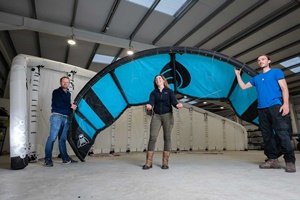 RWE put its new airborne wind test facility in Ireland to work for the first time, enabling the maiden flight of a new kite technology by Kitepower in Bangor Erris, County Mayo, Ireland. RWE is testing Airborne Wind Energy in Ireland in collaboration with its technology partner Kitepower, its partners in Mayo County Council and the MegaAwe Project, with funding from Interreg North West Europe.
RWE put its new airborne wind test facility in Ireland to work for the first time, enabling the maiden flight of a new kite technology by Kitepower in Bangor Erris, County Mayo, Ireland. RWE is testing Airborne Wind Energy in Ireland in collaboration with its technology partner Kitepower, its partners in Mayo County Council and the MegaAwe Project, with funding from Interreg North West Europe.Kitepower uses a Kite Control Unit (KCU) attached to the tether, to control the direction the kite flies. The Dyneema tether (an ultra-strong rope which has a higher strength than steel wire of the same dimension but less than one tenth of its weight) is attached to a Ground Station, housed in a conventional 20 foot container. The ground station has a generator which converts the mechanical energy of the kite into electricity. Electricity is produced in the “Reel Out Phase” when the kite is flown in a cross-wind figure of eight pattern achieving a high pulling force which pulls out the tether from the winch in the ground station. During this Reel Out Phase, the Kitepower “Falcon” produces electricity. When the tether reaches its maximum, the kite is directed back to directly above the ground station by the KCU and the tether is reeled in using a small amount of energy. This is known as the “Reel In Phase”. When the Reel in Phase is complete, the Reel Out Phase begins again. Normally these two phases take 100 seconds, 80 seconds for Reel Out and 20 seconds for Reel In.










